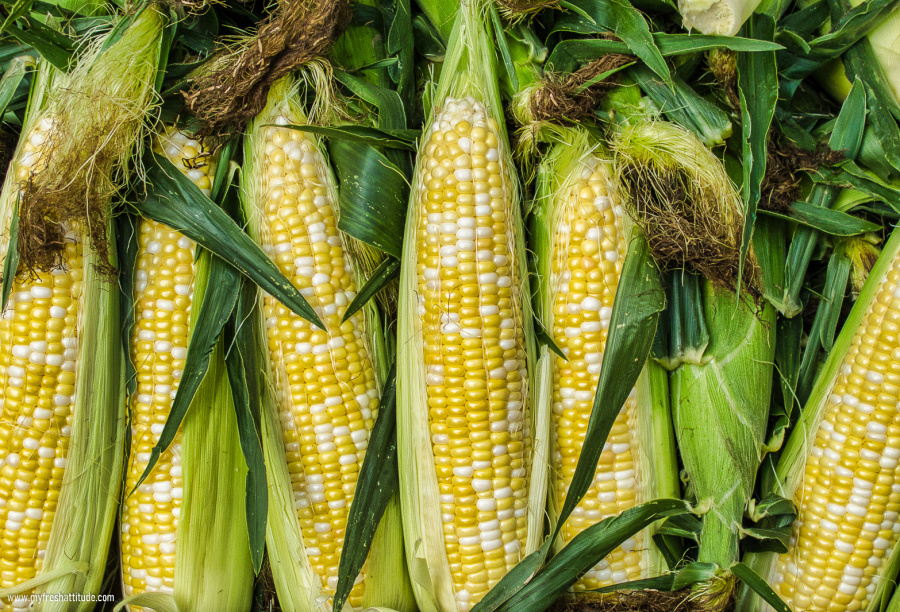
Sweet Corn
There are certain vegetables that seemingly take over their respective season: asparagus in spring, squash/pumpkins in autumn, cabbage in winter and corn in late summer. I love going to the markets and seeing stacks of corn, even though it reminds me the summer season is coming to a close.
I ate a lot of corn growing up in America…mostly the highly standard corn-on-the-cob accompanying most picnics or served at any large gathering like a county fair. I even enjoyed getting lost amongst the giant stalks and nipping a few immature cobs to enjoy raw. It was so sweet and filled with intense corn flavor. How could a kid not enjoy that moment?
I didn’t realize it at the time, but tasting that raw corn perfectly demonstrated the need to eat it as soon as you can after harvest, or as farmers like to say, “don’t pick the corn until the water begins to boil.”. Now I know why. Once picked, the natural sugar in corn converts to starch and the sweetness is lost.
Most people continue to enjoy corn-on-the-cob without exploring some of the many other ways to eat and prepare fresh sweet corn. But sweet corn can turn into a deliciously creamy soup, a fresh salsa-like salad, crispy fritters and even as a raw salad. For me, the versatility and flavor headlines many late summer meals.
Get to Know: Most people think of sweet corn more as a vegetable than its true nature as a grain. But then again, most grains are not consumed in the same manner as fresh sweet corn, which can be enjoyed raw.
For the most part, sweet corn is either yellow or white, although there are varieties that combine yellow with white – and even blue or ancient red varieties exist. The vast majority in supermarkets and farmer’s markets are the larger, full-flavored yellow varieties. The lesser available white varieties are smaller and have sweeter kernels.
Modern hybrids are quite sweet and lack intensive corn flavor. They were developed to increase shelf life and look more pleasing to the consumer. Most smaller markets or farmers will sell more traditional varieties that taste vastly better.
There are many other culinary uses for corn: corn meal (polenta and grits), hominy, corn flour, corn starch and masa harina.
Season: Depending on where you live in the world, sweet corn is mostly available during late summer and into the early portion of fall.
Selecting and Storing: Look for bright green, tightly fitting husks and golden brown silk. Ideally, the husks should complete cover the kernels inside, which helps the corn stay fresh and sweet. You can lift back a portion of the husk to examine the kernels. They should appear plump and extend along the entire ear in tightly packed rows. The stem end should be green and moist. A woody appearance indicates age. If you have the nerve to check, poke a small hole in one of the kernels – the juice flowing from the interior should be milky. A clear juice indicates immaturity and no juice coming from a wrinkled kernel indicates age.
Fresh corn should be cooked and consumed the day it is purchased. If you need to store it for a day or two, then make sure you keep the husk intact and refrigerate loosely packed in a mesh or plastic bag.
Freezing fresh corn is possible. It is best to remove the husk and silk, clean the corn and remove the kernels. Make sure the kernels are cooled, then place in a freezer bag. Frozen kernels will last about 6 months in the freezer.
Preparing and Cooking: Fresh sweet corn on the cob can be steamed, boiled or grilled. Corn kernels are excellent when sautéed, roasted or quickly blanched.
Sweet corn does not require a lot of cooking – just long enough to heat the kernels…anywhere between 3 and 10 minutes depending on the cooking method you are using. Sweet corn can also be eaten raw, especially if it is very fresh.
Soaking whole corn for 20 minutes in cold water before removing the husks and silks keeps the corn moist and helps when stripping the husks and removing the silk strands.
To clean corn, pull the husks down from the tip end and toward the stem end. Twist off the husks. Wipe the cob with a clean towel or with your hands under running water to remove the silky bits.
To remove the kernels from the cob, hold onto the stem end of the corn, pointing the tip of the ear down. Run a small serrated knife down the cob to cut off the kernels, making sure you gauge the right depth – just below the kernel, but avoiding a deep dive into the ear. Rotate the cob and continue taking off strips of kernels. This job is a bit messy, so use a baking tray or large bowl to capture the kernels. Run the back end of your knife along the cob to release any milk from the cob – this is very tasty!
Nutritional Info: Fresh sweet corn is very high in protein in carbohydrates. It is also an excellent source of fiber, B vitamins and a host of antioxidants.
Jack’s Fresh Tip

The key to drawing out the most flavor in sweet corn is to cook it quickly and of course, purchase the freshest possible corn you can find.
One of the simplest methods to prepare sweet corn is to cook the entire cob. Make sure you begin by soaking the cob in cold water for about 20 minutes. This will help draw out any hidden bugs and keep the kernels nice and moist. Remove the husk and silks. To Boil: Place cleaned ears of corn in lightly salted boiling water and cook 4-5 minutes. Remove, drain and season the warm corn. To Steam: Placed cleaned ears of corn in a steamer tray – making sure the steamer is hot and producing steam. Cover and steam 8-10 minutes. Remove and season warm corn. To Shallow Steam: Add about 3 or 4-cm (about 1 or 2 inches) of water to a wide pot large enough to hold the corn. Bring to a boil – don’t salt the water – cover the pot tightly and cook 7 minutes over high heat.
My favorite seasoning for cooked corn on the cob is to combine unprocessed rapeseed oil, ground chili powder and smoked paprika to taste. I add the juice of a lime, then brush on freshly cooked and warm corn.
Recipes with Sweet Corn
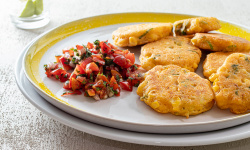
Sweet Corn Fritters
0 0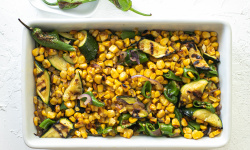
Grilled Zucchini, Corn and Peppers
0 0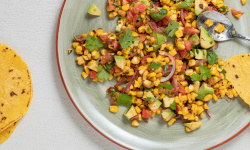
Grilled Corn Salsa with Avocados
1 0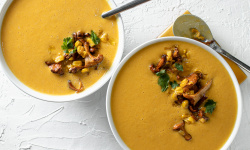
Sweet Corn and Garlic Soup
4 2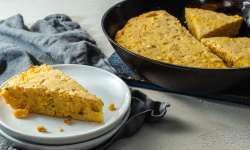
Vegan Skillet Cornbread
2 0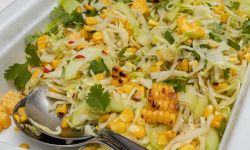
There are no comments